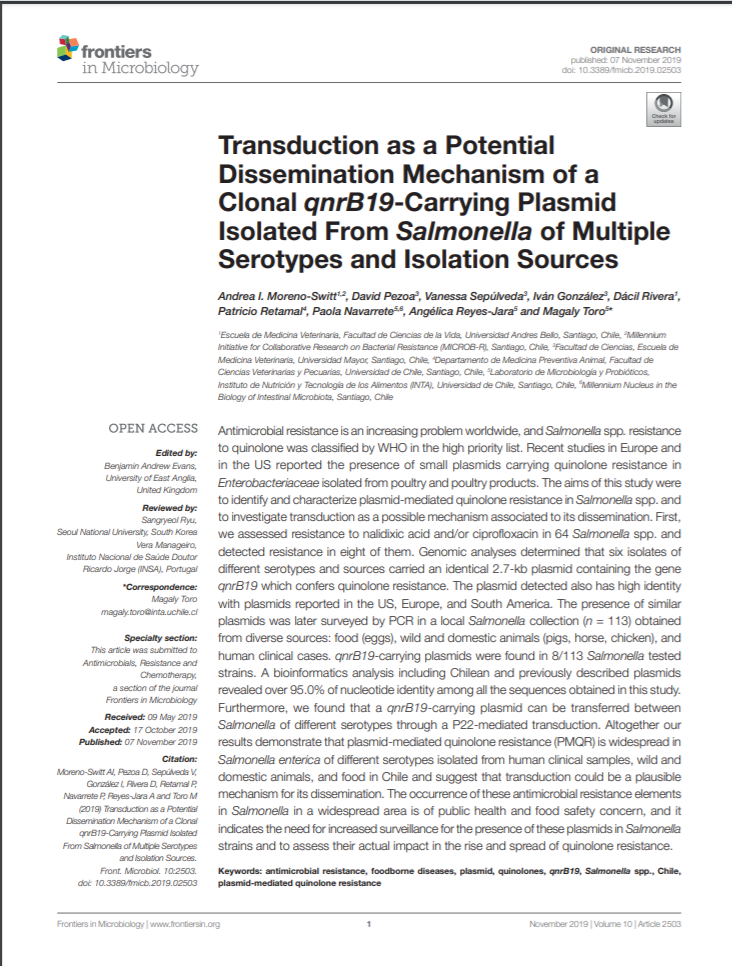Transduction as a Potential Dissemination Mechanism of a Clonal qnrB19-Carrying Plasmid Isolated From Salmonella of Multiple Serotypes and Isolation Sources

Fecha
DOI: 10.33Autor
González, Iván [Univ Mayor, Escuela Med Vet, Fac Ciencias, Santiago, Chile]
Sepúlveda, Vanessa [Univ Mayor, Escuela Med Vet, Fac Ciencias, Santiago, Chile]
Pezoa, David [Univ Mayor, Escuela Med Vet, Fac Ciencias, Santiago, Chile]
Moreno-Switt, Andrea, I
Rivera, Dacil
Retamal, Patricio
Navarrete, Paola
Reyes-Jara, Angelica
Toro, Magaly
Ubicación geográfica
Notas
HERRAMIENTAS
Acceda a títulos restringidos
¿Cómo descargar?Resumen
Antimicrobial resistance is an increasing problem worldwide, and Salmonella spp. resistance to quinolone was classified by WHO in the high priority list. Recent studies in Europe and in the US reported the presence of small plasmids carrying quinolone resistance in Enterobacteriaceae isolated from poultry and poultry products. The aims of this study were to identify and characterize plasmid-mediated quinolone resistance in Salmonella spp. and to investigate transduction as a possible mechanism associated to its dissemination. First, we assessed resistance to nalidixic acid and/or ciprofloxacin in 64 Salmonella spp. and detected resistance in eight of them. Genomic analyses determined that six isolates of different serotypes and sources carried an identical 2.7-kb plasmid containing the gene qnrB19 which confers quinolone resistance. The plasmid detected also has high identity with plasmids reported in the US, Europe, and South America. The presence of similar plasmids was later surveyed by PCR in a local Salmonella collection (n = 113) obtained from diverse sources: food (eggs), wild and domestic animals (pigs, horse, chicken), and human clinical cases. qnrB19-carrying plasmids were found in 8/113 Salmonella tested strains. A bioinformatics analysis including Chilean and previously described plasmids revealed over 95.0% of nucleotide identity among all the sequences obtained in this study. Furthermore, we found that a qnrB19-carrying plasmid can be transferred between Salmonella of different serotypes through a P22-mediated transduction. Altogether our results demonstrate that plasmid-mediated quinolone resistance (PMQR) is widespread in Salmonella enterica of different serotypes isolated from human clinical samples, wild and domestic animals, and food in Chile and suggest that transduction could be a plausible mechanism for its dissemination. The occurrence of these antimicrobial resistance elements in Salmonella in a widespread area is of public health and food safety concern, and it indicates the need for increased surveillance for the presence of these plasmids in Salmonella strains and to assess their actual impact in the rise and spread of quinolone resistance.
URI
Moreno Switt, A. I., Pezoa, D., Sepulveda, V., Gonzalez, I., Rivera, D., Retamal, P., ... & Toro, M. (2019). Transduction as a potential dissemination mechanism of a clonal qnrB19-carrying plasmid isolated from Salmonella of multiple serotypes and isolation sources. Frontiers in Microbiology, 10, 2503.http://repositorio.umayor.cl/xmlui/handle/sibum/6539
Coleccion/es a la/s que pertenece:
Si usted es autor(a) de este documento y NO desea que su publicación tenga acceso público en este repositorio, por favor complete el formulario aquí.